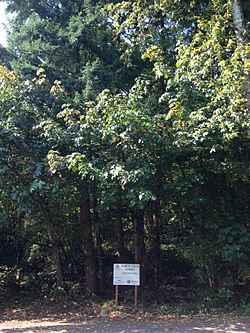North Creek Forest
Quick facts for kids North Creek Forest |
|
|---|---|

North Creek Forest in Bothell, WA
|
|
| Location | Bothell, Washington |
| Nearest city | Seattle |
| Area | 64 acres (23 privately owned) |
| Designation | Priority Habitat |
| Established | December 2011 |
The North Creek Forest is a special natural area in Bothell, Washington. It covers about 64 acres and surrounds a part of North Creek. This forest is made up of mature trees that have grown back after older trees were cut down long ago. It has 7 streams and 9 wetlands, which are like marshy areas.
This forest acts like a long, green pathway, or "habitat corridor," for animals. It stretches for about one mile, connecting different natural areas. It's one of the last big forests like this left in the Bothell area. The trees here help keep the water in the streams and wetlands clean and cool. This cool water is super important for five types of fish, like salmon and steelhead, that lay their eggs in North Creek. The forest also helps the environment in many other ways, like cleaning the air and reducing flooding.
Contents
What Makes North Creek Forest Special?
North Creek Forest is a vital part of the local environment. It helps keep the air clean and provides a home for many animals.
Trees and Plants of the Forest
The forest is home to many different kinds of trees. Some of the most common ones are:
- Douglas-fir (Pseudotsuga menziesii)
- Western redcedar (Thuja plicata)
- Western hemlock (Tsuga heterophylla)
- Big-leaf maple (Acer macrophyllum)
- Red alder (Alnus rubra)
These trees create a thick forest, especially with western red cedar, Douglas-fir, and big-leaf maple growing together.
Animals Living in North Creek Forest
Many amazing animals call North Creek Forest their home. You might spot some of these creatures:
- Black-tailed deer
- Douglas squirrels
- Mountain beavers
- Different types of owls, like barred owls and great horned owls
- Hawks, such as Cooper's hawks and merlins
- Pileated woodpeckers
- Pacific tree frogs
These animals rely on the forest for food, shelter, and places to raise their young.
Protecting the Forest
For a long time, building new homes and businesses was the biggest threat to North Creek Forest. Now, a major challenge is dealing with "invasive species." These are plants that are not native to the area and can take over, harming the native plants.
Dealing with Invasive Plants
Some of the most common invasive plants in the forest include:
- Himalayan blackberry (Rubis bifrons)
- English ivy (Hedera helix)
- Reed canary grass (Phalaris arundinacea)
These plants can cause problems by using up water, space, and sunlight that native plants need. They can also stop the forest from growing and changing naturally over time.
Working Together to Restore the Forest
Since 2011, many groups have been working together to protect and restore North Creek Forest. This partnership helps make sure that wetlands are not lost and that the forest becomes healthier. It also helps increase the number of different plants and animals living there.
The Friends of North Creek Forest group works with the University of Washington's Restoration Ecology Network. This gives students a chance to learn about and practice real-world ways to restore natural areas. A healthy North Creek Forest is important because it's a green space in a busy city area.
North Creek Forest as a Classroom
North Creek Forest is also used as an outdoor classroom for students of all ages.
- University students, including those studying for advanced degrees, use it for research.
- It's a regular site for the University of Washington's restoration ecology program.
- Many classes from the University of Washington Bothell use it as a "living classroom."
- Even elementary school students and older visit the forest for educational trips.
How the Forest Was Saved
In November 2015, the City of Bothell received a special award and grant called the Bravo Award. This money helped Bothell buy the last 22 acres needed to protect the entire 64-acre North Creek Forest. With more funding, on November 8, 2016, the Bothell City Council officially approved buying the final piece of land. This important step helped make sure the whole forest would be saved for everyone to enjoy.

